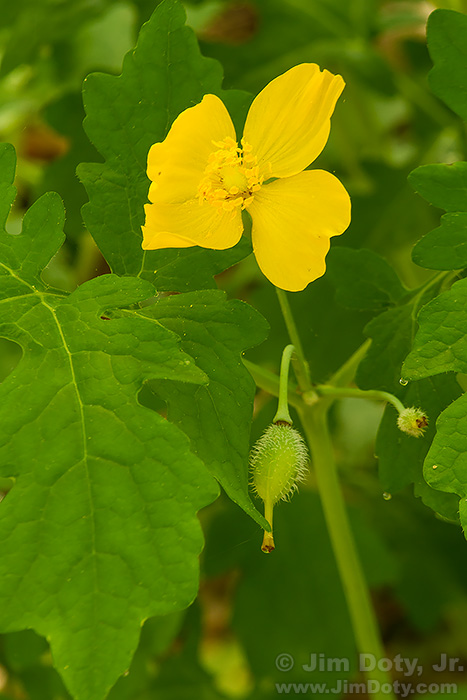On my way home from my photography workshop in Grand Rapids/Holland, another photographer and I stopped at West Lake Nature Preserve in Portage, Michigan. It is one of my favorite nature photography locations in southwest Michigan. Something is happening there most any time of year.
There is usually some wildlife around. On this trip we saw deer and all kinds of birds including a swan, some geese, several ducks, and Red-winged blackbirds in the marsh.
Something is almost always in bloom from early spring to fall. Mayapple, Jack-in-the-Pulpit, and Wood poppies were in bloom, and the Pitcher Pants were about to bloom.
I picked a Wood Poppy (Celandine Poppy) with nice leaf patterns in the foreground and background. The 200 mm focal length of the lens gave me a sufficiently soft background. On my Canon 7D body the field of view crop gives a 200 mm lens an equivalent 35 mm focal length of 320 mm.
The big challenge in the low light beneath the forest canopy was the almost constant breeze. Even at ISO 400 my shutter speed was still a very slow 1/5 of a second. Using an ISO of 100 made the shutter speed impossibly long in the breezy conditions. Any breeze at all at that slow a shutter speed will blur the image. Of course my camera was on a tripod.
I used mirror lockup with a 2 second self-timer delay to insure that I didn’t jiggle the camera while pushing the shutter and that mirror slap didn’t create any problems. Any time you are using a long lens and a shutter speed from 1/30 to 1/2 second, the movement of the reflex mirror just prior to the shutter opening can cause unsharp photos. Mirror lockup is the solution to that problem. You can delay the time between the mirror going up and the shutter opening so the mirror movement doesn’t blur the photo. For that reason, mirror lockup is a very important camera feature for landscape and nature photographers.
The breeze was still a problem. The breeze would quit, I would touch the shutter, the mirror would bounce up and two seconds later the shutter would fire. But during that two second delay the breeze would often start back up again. I took a lot of photos and most of them were blurred. Patience finally paid off and I got a few sharp photos.
Photo Data: Canon 7D. Canon EF 70-200mm f/4L IS USM lens at 200 mm. 1/5 sec;Â Â f/16;Â Â ISO 400.
Links
Field of View Crop. The sensors in many digital SLRs (DSLRs) are smaller than full frame 24×36 mm digital sensors (and 35mm film frames). When a lens that was originally designed for a full frame digital camera (or a 35mm film camera) is put on a digital camera body with a smaller sensor, the field of view is different. This article explains why.
To learn more about nature photography, closeup photography, depth of field, and focal lengths, read Digital Photography Exposure for Dummies. One of the highest rated photography books at Amazon.com, you can order it here through Amazon’s third-party sellers.
Nature Photography Books: The Three Essentials. If you love nature photography, put these books on your “must read†list.
The Best “How To†Nature Photography Books
Great “How To†Flower Photography Book by Tony Sweet
West Lake Nature Preserve. Michigan DNR site.
West Lake Nature Preserve. City of Portage site.

